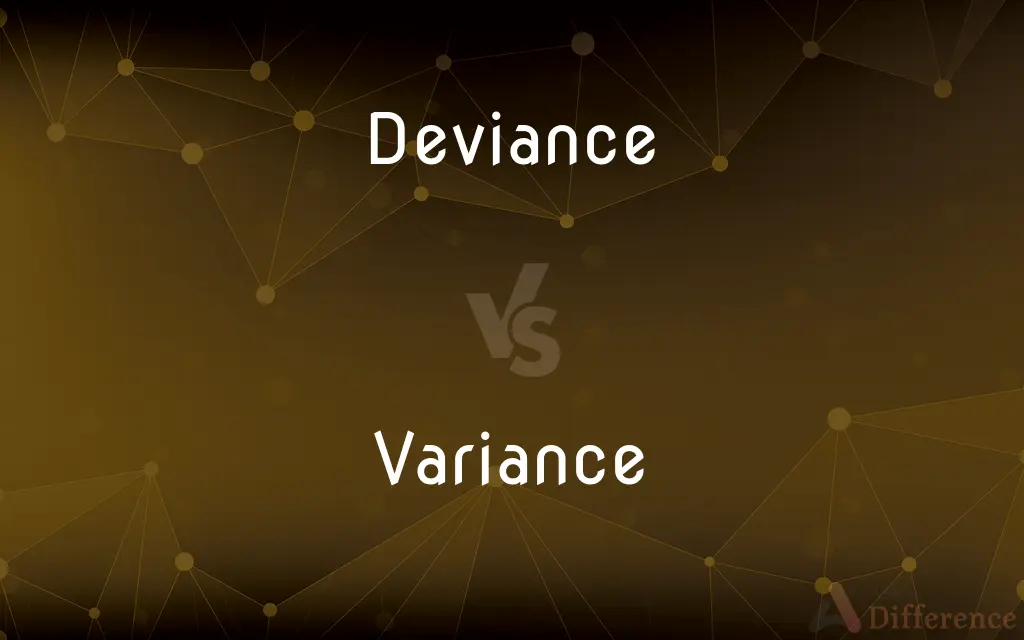Deviance vs. Variance — What's the Difference?
Edited by Tayyaba Rehman — By Fiza Rafique — Updated on March 21, 2024
Deviance measures how well a model fits data, while variance quantifies data dispersion from the mean.

Difference Between Deviance and Variance
Table of Contents
ADVERTISEMENT
Key Differences
Deviance is a statistical term used primarily in the context of model fitting, particularly in generalized linear models, to describe the difference between a fitted model and the saturated model. It helps in assessing the goodness of fit. Variance, on the other hand, is a fundamental concept in statistics that measures the spread of a set of data points around their mean value, indicating how much the data points differ from the mean.
While deviance is concerned with the fit of a model to data and is used to compare models, variance focuses on the variability within a dataset itself, regardless of any modeling. Deviance is a more specialized term, used mainly in specific statistical modeling contexts, whereas variance is a broad concept applicable in numerous statistical analyses to describe data distribution.
Deviance can be used to compare different models for the same data by examining which model has the lower deviance, indicating a better fit. Variance is used to understand the distribution of data points, with higher variance indicating greater spread and lower variance indicating tighter clustering around the mean.
The calculation of deviance involves comparing the likelihood of the fitted model to that of a perfect model (saturated model), which can vary depending on the type of model and data. Variance is calculated as the average of the squared differences from the Mean, providing a clear, straightforward measure of spread.
Both deviance and variance are important in statistical analysis but serve different purposes: deviance for model comparison and goodness of fit, and variance for understanding data dispersion.
ADVERTISEMENT
Comparison Chart
Definition
Measure of fit between a model and observed data.
Measure of the spread of data points around the mean.
Context
Model fitting, particularly in generalized linear models.
General statistical analysis to describe data distribution.
Usage
Comparing models, assessing goodness of fit.
Understanding data variability, indicating dispersion.
Calculation
Difference in likelihood between fitted and saturated models.
Average of squared differences from the mean.
Focus
Model-data fit.
Data point spread.
Compare with Definitions
Deviance
A statistical measure of the goodness of fit of a model.
Lower deviance indicates a model that better fits the observed data.
Variance
A measure of the dispersion of a set of data points.
High variance indicates that the data points are spread out from the mean.
Deviance
Used to compare models by examining the difference in their likelihoods.
Choose the model with the lower deviance for a better fit to the data.
Variance
Quantifies how much the data points differ from the average.
The variance in test scores shows a wide range of student performance.
Deviance
A tool in generalized linear models to assess model adequacy.
The deviance of the regression model was used to evaluate its effectiveness.
Variance
Calculated as the average of the squared differences from the mean.
To find the variance, square each difference from the mean and then average those values.
Deviance
Indicates how well a model represents the data it's fitted to.
The model's low deviance suggests it captures the underlying data patterns well.
Variance
Indicates the variability within a dataset.
The low variance suggests that the measurements are very consistent.
Deviance
Reflects the discrepancy between a fitted model and the perfect fit.
Minimizing deviance helps in achieving a model that closely matches the observed data.
Variance
Fundamental in assessing data spread and distribution.
Analyzing the variance helps in understanding the distribution characteristics of the dataset.
Deviance
Differing from a norm or from the accepted standards of a society.
Variance
In probability theory and statistics, variance is the expectation of the squared deviation of a random variable from its mean. Variance is a measure of dispersion, meaning it is a measure of how far a set of numbers is spread out from their average value.
Deviance
One that differs from a norm, especially a person whose behavior and attitudes differ from accepted social standards.
Variance
The fact or quality of being different, divergent, or inconsistent
Her light tone was at variance with her sudden trembling
The stylistic variances of classical dance
Deviance
(sociology) Actions or behaviors that violate formal and informal cultural norms such as laws and customs.
Variance
An official dispensation from a rule or regulation, typically a building regulation.
Deviance
A person or thing that differs from the expected. en
Variance
The state or quality of being variant or variable; variation
Considerable variance in temperature across the region.
Deviance
An aberrant state or condition.
Variance
Difference or inconsistency
Your behavior is at variance with your beliefs.
Deviance
Deviate behavior.
Variance
The state or fact of being in disagreement or in conflict
I am at variance with her over who should pay for the damage.
Deviance
A state or condition markedly different from the norm
Variance
A discrepancy between two statements or documents, especially between the charge in a criminal indictment and the evidence presented.
Deviance
Deviate behavior
Variance
An exception to the application of a usual rule, granted by an authority on the basis of hardship or practicality
A zoning variance.
Variance
(Statistics) The square of the standard deviation.
Variance
(Chemistry) The number of thermodynamic variables, such as temperature and pressure, required to specify a state of equilibrium of a system, given by the phase rule; the degrees of freedom of a system.
Variance
The act of varying or the state of being variable.
Variance
A difference between what is expected and what is observed; deviation.
Variance
The state of differing or being in conflict.
Variance
An official permit to do something that is ordinarily forbidden by regulations.
Variance
(law) A discrepancy between two legal documents.
Variance
(law) A departure from a cause of action originally in a complaint.
Variance
(statistics) The second central moment in probability.
Variance
The number of degrees of freedom in a system.
Variance
Covariance and contravariance generally.
Depending on the variance of the type constructor, the subtyping relation of the simple types may be either preserved, reversed, or ignored for the respective complex types.
Variance
The quality or state of being variant; change of condition; variation.
Variance
Difference that produces dispute or controversy; disagreement; dissension; discord; dispute; quarrel.
That which is the strength of their amity shall prove the immediate author of their variance.
Variance
A disagreement or difference between two parts of the same legal proceeding, which, to be effectual, ought to agree, - as between the writ and the declaration, or between the allegation and the proof.
Variance
The expected value of the square of the deviation from the mean of a randomly distributed variable; the second moment about the mean. This is also the square of the standard deviation.
Variance
An event that departs from expectations
Variance
Discord that splits a group
Variance
The second moment around the mean; the expected value of the square of the deviations of a random variable from its mean value
Variance
A difference between conflicting facts or claims or opinions;
A growing divergence of opinion
Variance
The quality of being subject to variation
Variance
An activity that varies from a norm or standard;
Any variation in his routine was immediately reported
Common Curiosities
How does variance relate to standard deviation?
Standard deviation is the square root of variance and also measures data spread, but it is in the same units as the data, making it more interpretable.
What does high deviance indicate?
High deviance indicates a poor fit between the model and the observed data, suggesting the model may not adequately capture the underlying pattern.
Can deviance be used for model selection?
Yes, deviance can be used for model selection, typically by comparing the deviance of different models to identify the one that best fits the data.
Can variance be negative?
No, variance cannot be negative since it's calculated as the average of squared differences, which are always non-negative.
Does a lower deviance always mean a better model?
While lower deviance indicates a better fit to the observed data, it's also important to consider model complexity and the risk of overfitting.
How is variance used in finance?
In finance, variance is used to measure the volatility of an asset's returns, providing insight into the investment's risk.
How do you interpret a small vs. large variance?
A small variance indicates that data points are closely clustered around the mean, while a large variance indicates a wide spread of data points.
Can two different models have the same deviance?
Yes, different models can have the same deviance, but this does not necessarily mean they fit the data in the same way or have the same predictive power.
Is deviance only used in linear models?
Deviance is primarily used in the context of generalized linear models (GLMs), which include but are not limited to linear models.
Why is variance important in statistics?
Variance is important because it provides a quantitative measure of the variability in a dataset, which is crucial for understanding the data's distribution and for further statistical analyses.
What role does variance play in machine learning?
In machine learning, variance is part of the bias-variance tradeoff, indicating how much a model's predictions vary for different training sets.
What does zero variance indicate?
Zero variance indicates that all data points are identical and there is no variability within the dataset.
Can the concept of deviance be applied to non-statistical models?
Deviance is specifically a statistical concept and is not typically applicable to models outside of statistical or probabilistic frameworks.
How does variance affect statistical significance?
Variance affects statistical significance by influencing the spread of data points, which can impact the confidence in drawing conclusions from statistical tests.
Is it possible to have negative deviance?
Deviance is typically non-negative, but in some cases, computational or rounding errors can result in slightly negative values.
Share Your Discovery

Previous Comparison
Eternally vs. Forever
Next Comparison
Bingo vs. LottoAuthor Spotlight
Written by
Fiza RafiqueFiza Rafique is a skilled content writer at AskDifference.com, where she meticulously refines and enhances written pieces. Drawing from her vast editorial expertise, Fiza ensures clarity, accuracy, and precision in every article. Passionate about language, she continually seeks to elevate the quality of content for readers worldwide.
Edited by
Tayyaba RehmanTayyaba Rehman is a distinguished writer, currently serving as a primary contributor to askdifference.com. As a researcher in semantics and etymology, Tayyaba's passion for the complexity of languages and their distinctions has found a perfect home on the platform. Tayyaba delves into the intricacies of language, distinguishing between commonly confused words and phrases, thereby providing clarity for readers worldwide.














































